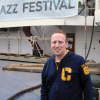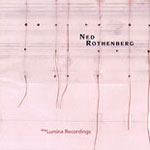Home » Jazz Articles » Album Review » Ned Rothenberg: Solo Works - The Lumina Recordings
Ned Rothenberg: Solo Works - The Lumina Recordings
The Lumina Recordings, recorded between 1980 and 1985, represent the entire spectrum of solo improvisation on reed instruments. The two-disc set contains music from three albums that initially appeared on LP on Rothenberg's Lumina label, now available on CD for the first time. As a bonus, there are twenty minutes of previously unissued music (disc two, tracks 9-11).
On the opening Trials of the Argo," Rothenberg develops long saxophone sequences that intermingle with previously conceived sounds through overdubbing. Throughout the piece's 22 minutes, his playing moves in and out of the background sounds, creating an uniterrupted continuous musical flow.
Evan Parker, another influential solo saxophone improviser, introduced Rothenberg to the music of the Canadian Inuit people, whose traditional vocal music inspired him to record Continuo After the Inuit. Through circular breathing and multiphonics, Rothenberg creates an array of sounds resembling several interacting instruments and human voices, yet the saxophonist does not resort to any overdubs or electronics during the piece's nearly nineteen-minute duration. The vocal quality of Rothenberg's alto saxophone and the dance-like folk rhythms create an almost meditational atmosphere, yet his improvisations are never song-like melodies—they remain modernistic throughout.
Although The Lumina Recordings may be far removed from traditional conceptions of tonality, rhythm and melody, the set's relentless pulse keeps it from sounding overly abstract or hermetic. "My relationship to pulse drew much more from the dance-based roots of jazz and R&B and from love of folk music, Rothenberg states. Despite its jazz roots, Rothenberg's highly individual approach is an amalgamation of various musical traditions and styles, ranging from folk materials to minimal music and the innovations of New York's '80s Downtown scene.
The duos with alto saxophonist John Zorn ("Kakeai ) and drummer Gerry Hemmingway ("Polysemy ) fit well into this program. Most of the mid-'80s improvisations on the second disc are shorter than the earlier pieces on disc one. It is surprising that Rothenberg calls his later improvisations "not nearly as pre-planned as in the early 80s, because his playing seems controlled and structured throughout. It is almost impossible to figure out which parts were pre-arranged or composed, and which parts were spontaneously improvised.
Though they were recorded more than twenty years ago, these recordings sound fresh and innovative, confirming Ned Rothenberg's importance as an influential voice among contemporary improvisers. The 36-page booklet features Rothenberg's comments on his music, plus numerous photos and pictures.
Track Listing
Trials of the Argo; Continuo After the Inuit; Portal; Polysemy; Caeneus; Strata; Trespass; Caenis; Slapstick; Filigree; Kakeai; Taps; Wrestling with Water; Funhouse #1; Funhouse #2.
Personnel
Ned Rothenberg
saxophoneNed Rothenberg: alto saxophone, bass clarinet, processed bass clarinet, soprano double ocarina, woodwinds, trap set, homemade instruments; David Weinstein: live digital signal processing; John Zorn: alto saxophone; Gerry Hemingway: steel drum.
Album information
Title: Solo Works - The Lumina Recordings | Year Released: 2006 | Record Label: Tzadik
< Previous
The Dream
Next >
Sincerely Whatever
Comments
About Ned Rothenberg
Instrument: Saxophone
Related Articles | Concerts | Albums | Photos | Similar ToTags
For the Love of Jazz
 All About Jazz has been a pillar of jazz since 1995, championing it as an art form and, more importantly, supporting the musicians who create it. Our enduring commitment has made "AAJ" one of the most culturally important websites of its kind, read by hundreds of thousands of fans, musicians and industry figures every month.
All About Jazz has been a pillar of jazz since 1995, championing it as an art form and, more importantly, supporting the musicians who create it. Our enduring commitment has made "AAJ" one of the most culturally important websites of its kind, read by hundreds of thousands of fans, musicians and industry figures every month.




















